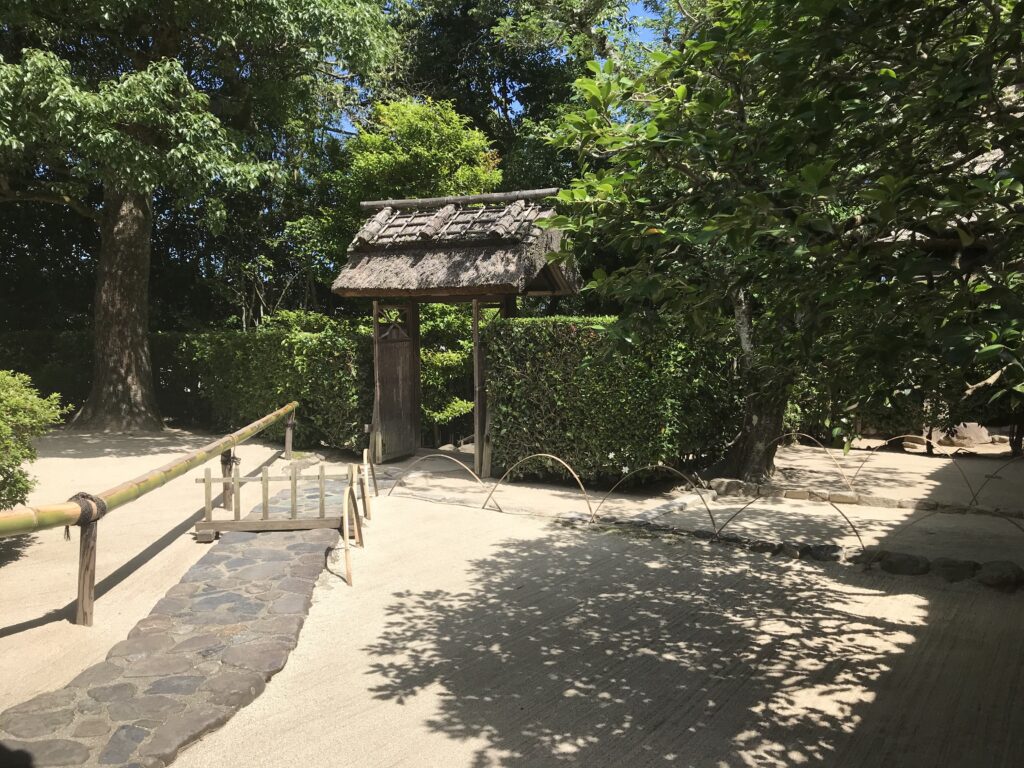一乗寺下り松の横を通って
またまた叡山電鉄に乗り庭園を巡りました。本日紹介するのは詩仙堂です。「一乗寺」駅で下車して、一路東に歩いていきます。途中、気を付けて見て欲しいのですが、かの宮本武蔵が戦った「一乗寺下り松」の横を通っていくことになります。



嘯月楼から庭を見る
さて、詩仙堂の門前に来ると、一見鄙びたような、それでいて洗練された竹垣が見え、この先に何が見えるのか期待が膨らみます。受付に着くまでの敷石も絵になるデザインで、思わず何枚も写真を撮ってしまいました。嘯月楼に入ると既に多くの人がいて、庭園を眺めていました。

若干季節がずれたのですが、運よく、サツキの花が一部残っていました。この建物の中には詩仙の間と呼ばれる部屋があり、そこに中国の詩家36人の肖像が掲げてあります。狩野探幽が描き、石川丈山が各詩人の詩を書いたとそうです。これが詩仙堂の名前の由来です。


石川丈山が晩年の30年を過ごした地
縁側から庭を眺めるだけでなく、庭に降りることも許可されています。地面に降りて、目の前の庭園から更に奥に下っていきます。池や橋など回遊式の庭園になっています。石川丈山は59歳で詩仙堂を造営し、30年以上この地での暮らしを楽しんだそうです。


庭を巡っていると、時々、コンッという音が響きます。これは“僧都”と呼ばれる添水(鹿おどし)で、丈山自身もこの音を愛していたと言われ、いまも残されているそうです。丈山は59歳から閑静に余生を過ごしたようですが、60代もまだまだ活躍したい自分にはできないなと思いました。(完)

詩仙堂の御朱印

詩仙堂が紹介されている書籍
烏賀陽百合さんの「しかけに感動する『京都名庭園』」に詩仙堂の庭園が解説されています。

しかけに感動する「京都名庭園」 京都の庭園デザイナーが案内 [ 烏賀陽 百合 ]
価格:1,760円
(2021/5/2 18:44時点)
感想(1件)
Shisendo (Kyoto)
Pass by the Ichijyoji downhill pine tree.
I took the Eizan Electric Railway again to tour the gardens. Today, I would like to introduce Shisen-do. I got off at “Ichijoji” station and walked eastward. On the way, please be careful to look out for the “Ichijyo-ji Downhill Pine Tree” where the famous samurai Miyamoto Musashi fought.
View of the garden from the Shogetsu Tower
Now, as I come to the gate of Shisendo, I saw a seemingly remote, yet sophisticated bamboo fence, and our anticipation of what lied ahead was heightened. The paving stones leading up to the reception desk were also picturesquely designed, and I couldn’t help but take a number of pictures. When I entered the hall, there were already many people enjoying the view of the garden.
It was slightly out of season, but luckily some of the satsuki flowers were still in bloom. In this building, there was a room called Shisen-no-Ma (Room of Poets), where portraits of 36 Chinese poets were displayed. It is said that Kano Tanyu painted the portraits and Ishikawa Jozan wrote the poems of each poet. This is the origin of the name Shisen-do.
Where Ishikawa spent the last 30 years of his life.
In addition to viewing the garden from the porch, I was allowed to go down into the garden. Descend to the ground and went further down from the garden in front of me. The garden was a circular garden with ponds and bridges. Ishikawa Jozan built Shisen-do at the age of 59 and enjoyed living here for over 30 years.
As I walked around the garden, I sometimes heard the sound of a “kong-kong”. It is said that Jozan himself loved this sound, and it still remains today. It seems that Jozan spent the rest of his life in tranquility from the age of 59, which I thought was not possible for me, as I still want to be active in my 60s. (End)
Shisendo (Kyoto)
Passez devant le pin de descente Ichijyoji.
J’ai repris le train électrique d’Eizan pour visiter les jardins. Aujourd’hui, je voudrais vous présenter Shisen-do. Je suis descendu à la station “Ichijoji” et j’ai marché vers l’est. En chemin, faites attention au “pin de la descente d’Ichijyo-ji” où le célèbre samouraï Miyamoto Musashi a combattu.
Vue du jardin depuis la tour Shogetsu
Maintenant, en arrivant à la porte de Shisendo, j’ai vu une clôture en bambou apparemment éloignée, mais sophistiquée, et notre anticipation de ce qui nous attendait était renforcée. Les pavés menant à la réception étaient également pittoresques, et je n’ai pas pu m’empêcher de prendre plusieurs photos. Lorsque je suis entré dans le hall, il y avait déjà de nombreuses personnes qui profitaient de la vue sur le jardin.
C’était un peu hors saison, mais heureusement, certaines des fleurs satsuki étaient encore en fleur. Dans ce bâtiment, il y avait une salle appelée Shisen-no-Ma (salle des poètes), où étaient exposés les portraits de 36 poètes chinois. On dit que Kano Tanyu a peint les portraits et que Ishikawa Jozan a écrit les poèmes de chaque poète. C’est l’origine du nom Shisen-do.
Où Ishikawa a passé les 30 dernières années de sa vie.
En plus d’observer le jardin depuis le porche, j’ai été autorisé à descendre dans le jardin. Descendre jusqu’au sol et aller plus loin dans le jardin devant moi. Le jardin était un jardin circulaire avec des étangs et des ponts. Ishikawa Jozan a construit Shisen-do à l’âge de 59 ans et a aimé y vivre pendant plus de 30 ans.
En me promenant dans le jardin, j’entendais parfois le son d’un “kong-kong”. On dit que Jozan lui-même aimait ce son, et il le fait encore aujourd’hui. Il semble que Jozan ait passé le reste de sa vie dans la tranquillité à partir de l’âge de 59 ans, ce que je pensais ne pas être possible pour moi, car je veux encore être actif à 60 ans. (Fin)
